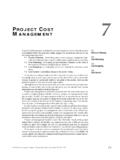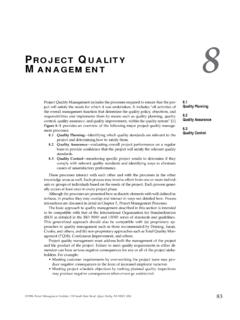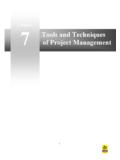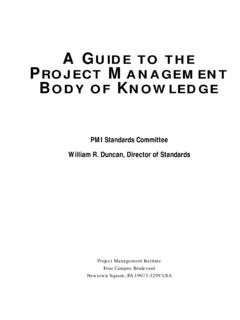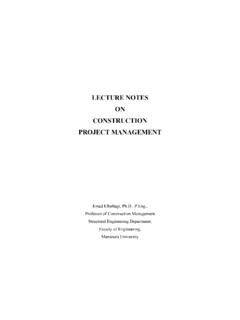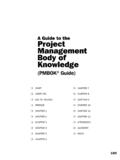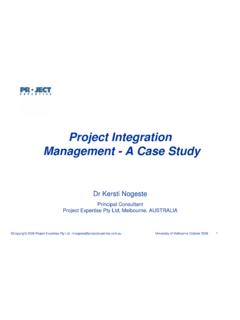Transcription of ROJECT COST ANAGEMENT - softwareresearch.net
1 project cost . management 7. project cost management includes the processes required to ensure that the project is completed within the approved budget. Figure 7 1 provides an overview of the Resource Planning following major processes: Resource Planning determining what resources (people, equipment, mate- rials) and what quantities of each should be used to perform project activities. cost Estimating cost Estimating developing an approximation (estimate) of the costs of the resources needed to complete project activities. cost Budgeting allocating the overall cost estimate to individual work cost Budgeting items. cost Control controlling changes to the project budget.
2 cost Control These processes interact with each other and with the processes in the other knowledge areas as well. Each process may involve effort from one or more indi- viduals or groups of individuals based on the needs of the project . Each process generally occurs at least once in every project phase. Although the processes are presented here as discrete elements with well-defined in- terfaces, in practice they may overlap and interact in ways not detailed here. Process interactions are discussed in detail in Chapter 3. project cost management is primarily concerned with the cost of the resources needed to complete project activities. However, project cost management should also consider the effect of project decisions on the cost of using the project product.
3 For example, limiting the number of design reviews may reduce the cost of the pro- ject at the expense of an increase in the customer's operating costs. This broader view of project cost management is often called life-cycle costing. In many application areas predicting and analyzing the prospective financial per- formance of the project product is done outside the project . In others ( , capital facilities projects), project cost management also includes this work. When such predictions and analysis are included, project cost management will include addi- tional processes and numerous general management techniques such as return on investment, discounted cash flow, payback analysis, and others.
4 project cost management should consider the information needs of the project stakeholders different stakeholders may measure project costs in different ways and at different times. For example, the cost of a procurement item may be measured when committed, ordered, delivered, incurred, or recorded for accounting purposes. When project costs are used as a component of a reward and recognition system (reward and recognition systems are discussed in Section ), controllable and uncontrollable costs should be estimated and budgeted separately to ensure that re- wards reflect actual performance. 1996 project management Institute, 130 South State Road, Upper Darby, PA 19082 USA 73.
5 FIGURE 7 1 A GUIDE TO THE project management BODY OF KNOWLEDGE. Figure 7 1. project cost management Overview project cost management Resource Planning cost Estimating .1 Inputs .1 Inputs .3 .1 Work breakdown structure .3 .1 Work breakdown structure .3 .2 Historical information .3 .2 Resource requirements .3 .3 Scope statement .3 .3 Resource rates .3 .4 Resource pool description .3 .4 Activity duration estimates .3 .5 Organizational policies .3 .5 Historical information .2 tools and techniques .3 .6 Chart of accounts .3 .1 Expert judgment .2 tools and techniques .3 .2 Alternatives identification .3 .1 Analogous estimating .3 Outputs .3 .2 Parametric modeling .3.
6 1 Resource requirements .3 .3 Bottom-up estimating .3 .4 Computerized tools .3 Outputs .3 .1 cost estimates .3 .2 Supporting detail .3 .3 cost management plan cost Budgeting cost Control .1 Inputs .1 Inputs .3 .1 cost estimates .3 .1 cost baseline .3 .2 Work breakdown structure .3 .2 Performance reports .3 .3 project schedule .3 .3 Change requests .2 tools and techniques .3 .4 cost management plan .3 .1 cost estimating tools and .2 tools and techniques .3 .1 techniques .3 .1 cost change control system .3 Outputs .3 .2 Performance measurement .3 .1 cost baseline .3 .3 Additional planning .3 .4 Computerized tools .3 Outputs .3 .1 Revised cost estimates .3 .2 Budget updates.
7 3 .3 Corrective action .3 .4 Estimate at completion .3 .5 Lessons learned 74 1996 project management Institute, 130 South State Road, Upper Darby, PA 19082 USA. project cost management On some projects, especially smaller ones, resource planning, cost estimating, and cost budgeting are so tightly linked that they are viewed as a single process ( , they may be performed by a single individual over a relatively short period of time). They are present- ed here as distinct processes because the tools and techniques for each are different. RESOURCE PLANNING. Resource planning involves determining what physical resources (people, equip- ment, materials) and what quantities of each should be used to perform project ac- tivities.
8 It must be closely coordinated with cost estimating (described in Section ). For example: A construction project team will need to be familiar with local building codes. Such knowledge is often readily available at virtually no cost by using local la- bor. However, if the local labor pool lacks experience with unusual or special- ized construction techniques, the additional cost for a consultant might be the most effective way to secure knowledge of the local building codes. An automotive design team should be familiar with the latest in automated as- sembly techniques. The requisite knowledge might be obtained by hiring a con- sultant, by sending a designer to a seminar on robotics, or by including some- one from manufacturing as a member of the team.
9 Inputs Tools & Techniques Outputs .1 Work breakdown .1 Expert judgment .1 Resource requirements structure .2 Alternatives .2 Historical information .2 identification .3 Scope statement .4 Resource pool description .5 Organizational policies Inputs to Resource Planning .1 Work breakdown structure. The work breakdown structure (WBS, described in Section ) identifies the project elements that will need resources and thus is the primary input to resource planning. Any relevant outputs from other planning processes should be provided through the WBS to ensure proper control..2 Historical information. Historical information regarding what types of resources were required for similar work on previous projects should be used if available.
10 3 Scope statement. The scope statement (described in Section ) contains the project justification and the project objectives, both of which should be considered explicitly during resource planning..4 Resource pool description. Knowledge of what resources (people, equipment, ma- terial) are potentially available is necessary for resource planning. The amount of detail and the level of specificity of the resource pool description will vary. For ex- ample, during the early phases of an engineering design project , the pool may in- clude junior and senior engineers in large numbers. During later phases of the same project , however, the pool may be limited to those individuals who are knowl- edgeable about the project as a result of having worked on the earlier phases.
